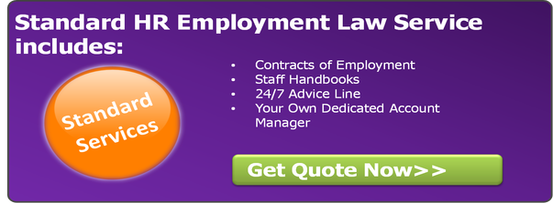Carer’s Leave – What Employers need to Know.
Carer’s Leave
In accordance with the provisions of the Carer’s Leave Act, 2001, if an employee has completed 12 months’ continuous service with you; he or she is entitled to take unpaid Carer’s Leave in order to care for a person (a ‘Relevant Person’) who requires full-time care and attention. Carer's Leave is protected leave.A ‘Relevant Person’
A ‘Relevant Person’ is a person who is over the age of 16 and is so incapacitated as to require full-time care and attention or a person who is under 16 and in receipt of a Domiciliary Care Allowance. A Deciding Officer of the Department of Social Protection determines whether or not an individual qualifies as a ‘Relevant Person’. Employees may be entitled to receive Carer’s Benefit/Carer’s Allowance whilst on leave. You should inform employees that they should apply to the Carer’s Benefit Section at their local Social Welfare Office so their eligibility can be assessed. There is no statutory obligation on you as an employer to pay employees during Carer’s Leave.Entitlements
Other than their right to remuneration, you should treat employees as though they have been working during a period of Carer’s Leave. Annual Leave and Public Holidays will accrue as normal for employees during the first 13 weeks of Carer’s Leave. The minimum statutory entitlement is 13 leave weeks and the maximum period is 104 weeks. The 104 weeks (2 years) can be taken in one continuous block or it can be broken up into multiple separate periods of leave – there must be a gap of at least 6 weeks between periods of Carer’s Leave.
Application/Notification
If one of your employees intends to avail of Carer’s Leave then he or she should write to you not less than 6 weeks before the proposed commencement of the leave in order to apply for this leave. The application should include the following details: - The manner in which the employee intends to take the leave
- The proposed commencement date and, where possible, end date (this won’t always be possible – especially if the ‘Relevant Person’ is terminally ill; for instance)
- That he or she has made an application to the Department of Social Protection for a decision to be made in respect of the person for whom they propose to avail of the leave
Termination of Carer’s Leave
Carer’s Leave may be terminated for several reasons. If it becomes apparent that the person for whom the care is being provided is not in need of full-time care any longer for whatever reason, you may terminate the leave. The Department of Social Protection will make a decision in certain instances. To download our Staff Suggestion Form click the image below ->







 If it is the employee that has made the decision to terminate the employment contract and he or she has carried out 13 weeks of continuous employment with the company then he or she is obliged to serve you, as the employer, with notice 1 week prior to the departure date (unless the contract of employment provides for a longer notice period).
If it is the employee that has made the decision to terminate the employment contract and he or she has carried out 13 weeks of continuous employment with the company then he or she is obliged to serve you, as the employer, with notice 1 week prior to the departure date (unless the contract of employment provides for a longer notice period).

It is very important to note that the Acts do not affect your right or that of the employee to terminate a contract of employment without notice due to the gross misconduct of the other party.
A Workplace Relations Customer Services department has been set up at the offices of the Department of Jobs, Enterprise and Innovation. This resulted from the amalgamation of the information services previously provided by the National Employment Rights Authority’s Contact Centre and the general enquiries areas of the Equality Tribunal, the Rights Commissioner Service and the Employment Appeals Tribunal.
It is very important to note that the Acts do not affect your right or that of the employee to terminate a contract of employment without notice due to the gross misconduct of the other party.
A Workplace Relations Customer Services department has been set up at the offices of the Department of Jobs, Enterprise and Innovation. This resulted from the amalgamation of the information services previously provided by the National Employment Rights Authority’s Contact Centre and the general enquiries areas of the Equality Tribunal, the Rights Commissioner Service and the Employment Appeals Tribunal.







 Managers are faced with a difficult task as they are continuously asked to reduce costs while simultaneously preserving the quality and service levels throughout the business.
Managers are faced with a difficult task as they are continuously asked to reduce costs while simultaneously preserving the quality and service levels throughout the business. This policy would direct employees as to how they should proceed when it comes to dealing with lights and heat and so on. The use of all unnecessary lighting and heating should be prohibited and lights/heat should be turned off when their use is not required.
Doors/windows should be opened/closed where possible in order to maintain temperature levels. Similarly, taps should not be allowed to drip and any concerns about resources should be reported to management so that they may be evaluated and rectified.
This policy would direct employees as to how they should proceed when it comes to dealing with lights and heat and so on. The use of all unnecessary lighting and heating should be prohibited and lights/heat should be turned off when their use is not required.
Doors/windows should be opened/closed where possible in order to maintain temperature levels. Similarly, taps should not be allowed to drip and any concerns about resources should be reported to management so that they may be evaluated and rectified.
 The use of paper and ink throughout the course of the working day is something that a lot of companies find to be expensive. It is important that employees only print items that they need to have in hardcopy in order to reduce the waste of paper and ink. It is also significant for employers to encourage employees to print on both sides where possible. E-mailing, rather than posting, documents is another practice that should be encouraged. Recycling/reusing paper, where possible, is also a practice that should be considered.
If it is a case that an employee finds himself or herself without assignments to complete during working hours or if their work has come to a standstill for one reason or another then he or she should be encouraged to offer assistance to colleagues who have yet to complete their workload.
In terms of productivity, employees should be prepared to start their working day by the time they are scheduled to begin work and should proceed with their work-related activities without delay. The same process should be followed after break/lunch periods and employees should not conclude their work until the time that they are scheduled to do so.
The use of paper and ink throughout the course of the working day is something that a lot of companies find to be expensive. It is important that employees only print items that they need to have in hardcopy in order to reduce the waste of paper and ink. It is also significant for employers to encourage employees to print on both sides where possible. E-mailing, rather than posting, documents is another practice that should be encouraged. Recycling/reusing paper, where possible, is also a practice that should be considered.
If it is a case that an employee finds himself or herself without assignments to complete during working hours or if their work has come to a standstill for one reason or another then he or she should be encouraged to offer assistance to colleagues who have yet to complete their workload.
In terms of productivity, employees should be prepared to start their working day by the time they are scheduled to begin work and should proceed with their work-related activities without delay. The same process should be followed after break/lunch periods and employees should not conclude their work until the time that they are scheduled to do so.
 If it becomes apparent that certain employees are struggling to organise their time then the provision of time-management training should be considered by management. It is also important to ensure that employees are aware of the most efficient methods of carrying out routine tasks (such as searching for documents or preparing spreadsheets) so time is used in the most efficient manner possible.
There are many techniques that a company can use to improve efficiency and exploring and implementing these methods is very important if a company is to remain competitive.
If it becomes apparent that certain employees are struggling to organise their time then the provision of time-management training should be considered by management. It is also important to ensure that employees are aware of the most efficient methods of carrying out routine tasks (such as searching for documents or preparing spreadsheets) so time is used in the most efficient manner possible.
There are many techniques that a company can use to improve efficiency and exploring and implementing these methods is very important if a company is to remain competitive. 
 In September 2013 the legal opinion of the European Court of Justice was that an Irish teacher (Ms. Z), whose child was born through surrogacy, did not have an automatic right to either paid Adoptive Leave or Maternity Leave from her employment.
In September 2013 the legal opinion of the European Court of Justice was that an Irish teacher (Ms. Z), whose child was born through surrogacy, did not have an automatic right to either paid Adoptive Leave or Maternity Leave from her employment.


 In exceptional circumstances or emergencies an employer is exempt from providing the above mentioned rest periods but only where he or she provides equivalent compensatory rest. Where the rest period is postponed the employer must allow the employee to take the compensatory rest within a reasonable period of time. Employees working in transport activities or certain categories of civil protection services are exempt from the statutory break regulations specified above (the equivalent compensatory rest rules do not apply for these employees).
Employers should be aware that employees have 6 months to make a complaint regarding breaks and rest periods in the workplace (in extreme circumstances this period can be extended to 12 months).
In exceptional circumstances or emergencies an employer is exempt from providing the above mentioned rest periods but only where he or she provides equivalent compensatory rest. Where the rest period is postponed the employer must allow the employee to take the compensatory rest within a reasonable period of time. Employees working in transport activities or certain categories of civil protection services are exempt from the statutory break regulations specified above (the equivalent compensatory rest rules do not apply for these employees).
Employers should be aware that employees have 6 months to make a complaint regarding breaks and rest periods in the workplace (in extreme circumstances this period can be extended to 12 months).

